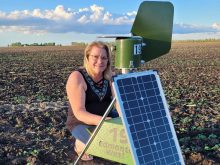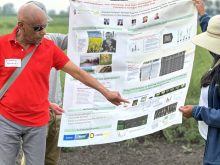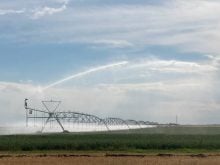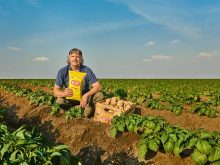Pushing a problem field to the front of the planting queue may reduce infection pressure later in the season
Verticillium wilt is a problem for a lot of crops in Manitoba, including canola, sunflowers and alfalfa.
In potatoes, the fungus Verticillium dahlia is the main cause of potato early die complex. In a 2021 interview with the Co-operator, Mario Tenuta, University of Manitoba soil scientist and main investigator with the Canadian Potato Early Dying Network, suggested the condition can cause yield loss of five to 20 per cent. Other research from the U.S. puts that number as high as 50 per cent.
It also becomes a marketing issue when stunted spuds fall short of processor preferences.
Read Also

Using artificial intelligence in agriculture starts with the right data
Good data is critical as the agriculture sector increasingly adopts new AI technology to drive efficiency, sustainability and trust across all levels of the value chain.
Verticillium in potatoes can significantly reduce yield and, being soil-borne, is difficult to manage.
Preliminary research results suggest earlier planting of risk-prone fields could reduce losses, in part due to colder soil temperatures earlier in the season.
Unlike other potato fungal issues that can be addressed with foliar fungicide, verticillium hides in the soil.
“Commonly we use soil fumigation and that’s very expensive,” said Julie Pasche, plant pathologist with North Dakota State University.
There are options. In 2017, labels expanded for the fungicide Aprovia, Syngenta’s broad-spectrum answer for leaf spots or powdery mildews in various horticulture crops. In-furrow verticillium suppression for potatoes was added to the label.
There has also been interest in biofumigation. Mustard has been tagged as a potential companion crop for potatoes, thanks to its production of glucosinolate and the pathogen- and pest-inhibiting substance isothiocyanate.
Last fall, producers heard that a new, sterile mustard variety specifically designed for biofumigation had been cleared for sale in Canada, although seed supplies for 2024 are expected to be slim. AAC Guard was specifically noted for its effectiveness against verticillium wilt.
Researchers at NDSU want to study the advantage of natural plant growth patterns.
“What we’d like to look at are other things we can do differently, like verticillium fertility management and water management, as well as some other areas and how they may be affected by planting date,” Pasche said.
The idea is to find a chink in the fungus’s life cycle.
Verticillium infects roots in the spring. From there, it colonizes the plant, moving through the root vascular tissue and into the stem. This is the cause of in-season vegetative wilting, Pasche noted.
As it progresses, plant cells die, leaving behind tell-tale black dots on dead tissue. Magnification of those dots reveals what look like dark bunches of grapes — tiny spheres containing melanized hyphae, a resting form of the fungus called microsclerotia.
The dark colour comes from melanin, the same pigment found in human skin. This pigmentation protects the microsclerotia from ultraviolet light.
In this resting form, the fungus can sleep in the soil for years until it contacts a viable host, like another potato plant. Research suggests these microsclerotia remain viable up to seven years. Inoculum builds with every vulnerable crop grown.
“As you grow more potato crops, you’re going to get more of the pathogen building up in the soil and more disease pressure year after year after year,” Pasche said.
“What we want to focus on in this research is what kind of factors are affecting that spring germination and growth of the fungus that allows it to infect the plant?”
Pasche pondered what might happen if a producer planted potatoes earlier. Could the practice put spud development out of sync with the fungus?
“Our objective was to evaluate the effect of planting date on verticillium wilt development,” she said.
Researchers used three varieties: the moderately susceptible Russet Burbank, moderately resistant Umatilla Russet and resistant Alturas. Over two years, the chosen test varieties were separated into strip plots (some fumigated and some not) and planted at three different dates ranging from April into late May.
Soil temperature was monitored from seeding through to emergence. Researchers looked for visual signs of verticillium wilt over the growing season. At harvest, Pasche and her team performed molecular soil tests to determine how much pathogen was lingering in each plot.
“In 2022, we had really great verticillium wilt pressure with very typical verticillium wilt symptoms and we were able to make some nice comparisons with visual symptoms as well.”
Pasche was mainly looking for two things: what time in the season did infection occur and, once harvest was done, how much inoculum did the potatoes generate and return to the soil as microsclerotia?
“In Russet Burbank, we are seeing that significant difference in pathogen returning back to the soil when we planted earlier and, when we move planting dates later, we’re getting more colonization of that stem tissue throughout the growing season and more return of that to the soil,” she said.
“Significant differences appear in Umatilla. In Alturas, (there was) very low colonization for a resistant variety and very little return back to the soil and no difference in the amount of colonization.”
The team then added soil temperature data to see how it might have influenced microsclerotia germination.
“The sclerotia may not germinate earlier in the growing season as effectively as they would when the soils warm up,” Pasche said. “The other part of it is, if the plant has a chance to get going and become more vigorous, you might not get that colonization.”
Those results are preliminary, but may point to a potential tactic to mitigate infection and subsequent release of inoculum, “if you have a situation where a field has high inoculum.”
“Maybe it’s had a lot of potato crops or you weren’t able to fumigate that field. Maybe you’re planting a susceptible cultivar. Certainly we saw those differences between Russet Burbank and some of the cultivars with some resistance,” Pasche said.
“That’s a situation where I’m hoping you can use this information to take that field and move it to the beginning of your planting schedule.”















